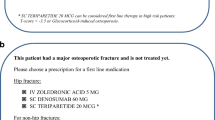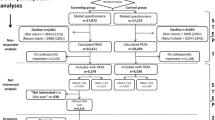Background
Despite recommendations, osteoporosis screening rates among women aged 65 years and older remain low. We present results from a clustered, randomized trial evaluating patient mailed reminders, alone and in combination with physician prompts, to improve osteoporosis screening and treatment.
Methods
Primary care clinics (n = 15) were randomized to usual care, mailed reminders alone, or mailed reminders with physician prompts. Study patients were females aged 65–89 years (N = 10,354). Using automated clinical and pharmacy data, information was collected on bone mineral density testing, pharmacy dispensings, and other patient characteristics. Unadjusted/adjusted differences in testing and treatment were assessed using generalized estimating equation approaches.
Results
Osteoporosis screening rates were 10.8% in usual care, 24.1% in mailed reminder, and 28.9% in mailed reminder with physician prompt. Results adjusted for differences at baseline indicated that mailed reminders significantly improved testing rates compared to usual care, and that the addition of prompts further improved testing. This effect increased with patient age. Treatment rates were 5.2% in usual care, 8.4% in mailed reminders, and 9.1% in mailed reminders with prompt. No significant differences were found in treatment rates between those receiving mailed reminders alone or in combination with physician prompts. However, women receiving usual care were significantly less likely to be treated.
Conclusions
The use of mailed reminders, either alone or with physician prompts, can significantly improve osteoporosis screening and treatment rates among insured primary care patients (Clinical Trials.gov number NCT00139425).

Similar content being viewed by others
Reference
U.S. Preventive Services Task Force. Screening for Osteoporosis in Postmenopausal Women: What’s New; An Overview of Recommendations. AHRQ Publication No. APPIP02-2005. 2002.
National Osteoporosis Foundation (NOF). Physician’s Guide to Prevention and Treatment of Osteoporosis. Washington, DC. NOF, 1999
U.S. Preventive Services Task Force. Screening for osteoporosis in postmenopausal women: recommendations and rationale. Ann Intern Med 2002; 137(6):526–8.
Morris CA, Cabral D, Cheng H, et al. Patterns of bone mineral density testing: Current guidelines, testing rates, and interventions. J Gen Intern Med. 2004;19(7):783–90.
U.S. Department of Health and Human Services. Bone Health and Osteoporosis: A Report of the Surgeon General. CH. 4. 2004. Washington, D.C.
Department of Health and Human Services. Access to Quality Health Services. Objectives for Improving Health (Part A: Focus Areas 1–4). In: Agency for Healthcare Research and Quality Health Resources and Services Administration, editor. Healthy People 2010. 2000:1–42.
Church TR, Yeazel MW, Jones RM, et al. A randomized trial of direct mailing of fecal occult blood tests to increase colorectal cancer screening. J Natl Cancer Inst. 2004;96(10):770–80.
Slater JS, Henly GA, Ha CN, et al. Effect of direct mail as a population-based strategy to increase mammography use among low-income underinsured women ages 40 to 64 years. Cancer Epidemiol Biomarkers Prev. 2005;14(10):2346–52.
Toth-Pal E, Nilsson GH, Furhoff AK. Clinical effect of computer generated physician reminders in health screening in primary health care—a controlled clinical trial of preventive services among the elderly. Int J Med Inform. 2004;73(9–10):695–703.
Schmittdiel J, McMenamin SB, Halpin HA, et al. The use of patient and physician reminders for preventive services: Results from a National Study of Physician Organizations. Prev Med. 2004;39(5):1001–06.
Szilagyi PG, Bordley C, Vann JC, et al. Effect of patient reminder/recall interventions on immunization rates. A review. JAMA. 2000;284(14):1820–27.
Smith DM, Zhou XH, Weinberger M, Smith F, McDonald RC. Mailed reminders for area-wide influenza immunization: A randomized controlled trial. J Am Geriatr Soc. 1999;47(1):1–5.
Balas EA, Weingarten S, Garb CT, Blumenthal D, Boren SA, Brown GD. Improving preventive care by prompting physicians. Arch Intern Med. 2000;160(3):301–8.
Feldstein A, Elmer PJ, Orwoll E, Herson M, Hillier T. Bone mineral density measurement and treatment for osteoporosis in older individuals with fractures: A gap in evidence-based practice guideline implementation. Arch Intern Med. 2003;163(18):2165–72.
Siris ES, Brenneman SK, Barrett-Connor E, et al. The effect of age and bone mineral density on the absolute, excess, and relative risk of fracture in postmenopausal women aged 50–99: Results from the National Osteoporosis Risk Assessment (NORA). Osteoporos Int. 2006;17:565–74.
Melton LJ, III, Kan SH, Frye MA, Wahner HW, O’Fallon WM, Riggs BL. Epidemiology of vertebral fractures in women. Am J Epidemiol. 1989;129(5):1000–11.
Barrett JA, Baron JA, Karagas MR, Beach ML. Fracture risk in the U.S. Medicare population. J Clin Epidemiol. 1999;52(3):243–9.
Ullom-Minnich P. Prevention of osteoporosis and fractures. Am Fam Physician. 1999;60(1):194–202.
White B, Fisher WD, Laurin DA. Rate of mortality for elderly patients after fracture of hip in the 1980’s. J Bone Jt Surg. 1987;69(9):1335–40.
Cauley JA, Thompson DE, Ensrud KC, Scott JC, Black D. Risk of mortality following clinical fractures. Osteoporos Int. 2000;11(7):556–61.
Florida Osteoporosis Board. Incidence and Economic Burden of Osteoporotic Fractures in The United States, 21005-2025. 2005.
Feldstein AC, Nichols GA, Elmer PJ, Smith DH, Aickin M, Herson M. Older women with fractures: patients falling through the cracks of guideline-recommended osteoporosis screening and treatment. J Bone Jt Surg Am. 2003;85-A(12):2294–302.
Solomon DH, Morris C, Cheng H, et al. Medication use patterns for osteoporosis: An assessment of guidelines, treatment rates, and quality improvement interventions. Mayo Clin Proc. 2005;80(2):194–202.
U.S. Preventive Services Task Force. Screening for Osteoporosis in Postmenopausal Women: Recommendations and Rationale. Ann Intern Med. 2002;137:526–8.
Solomon DH, Finkelstein JS, Polinski JM, et al. A randomized controlled trial of mailed osteoporosis education to older adults. Osteoporos Int. 2006;17(5):760–67.
Wroe AL, Salkovskis PM. The effects of ‘non-directive’ questioning on an anticipated decision whether to undergo predictive testing for heart disease: An experimental study. Behav Res Ther. 2000;38(4):389–403.
Stock JL, Waud CE, Coderre JA, et al. Clinical reporting to primary care physicians leads to increased use and understanding of bone densitometry and affects the management of osteoporosis. A randomized trial. Ann Intern Med. 1998;128(12 Pt 1):996–9.
Silverman SL, Greenwald M, Klein RA, Drinkwater BL. Effect of bone density information on decisions about hormone replacement therapy: A randomized trial. Obstet Gynecol. 1997;89(3):321–5.
Torgerson DJ, Thomas RE, Campbell MK, Reid DM. Randomized trial of osteoporosis screening. Use of hormone replacement therapy and quality-of-life results. Arch Intern Med. 1997;157(18):2121–5.
Rolnick SJ, Kopher R, Jackson J, Fischer LR, Compo R. What is the impact of osteoporosis education and bone mineral density testing for postmenopausal women in a managed care setting? Menopause. 2001;8(2):141–8.
LaCroix AZ, Buist DS, Brenneman SK, Abbott TA, III. Evaluation of three population-based strategies for fracture prevention: Results of the osteoporosis population-based risk assessment (OPRA) trial. Med Care. 2005;43(3):293–302.
Potential Financial Conflict of Interest
Dr. Weiss and Dr. Chen are employees of Merck & Co.
Author information
Authors and Affiliations
Corresponding author
Additional information
Funded by: Merck & Co., Inc.
Rights and permissions
About this article
Cite this article
Lafata, J.E., Kolk, D., Peterson, E.L. et al. Improving Osteoporosis Screening: Results from a Randomized Cluster Trial. J GEN INTERN MED 22, 346–351 (2007). https://doi.org/10.1007/s11606-006-0060-9
Published:
Issue Date:
DOI: https://doi.org/10.1007/s11606-006-0060-9




